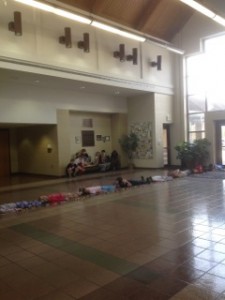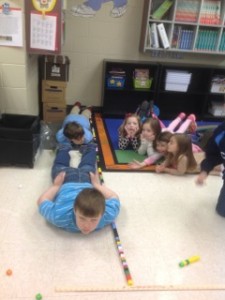Here is the part 1 and part 2 if you missed the previous posts.
I teach 2nd grade. Research is a new concept/skill for them. I decided to have my students do a lot of their research during reading groups on ipads. I did this for many reasons. The best reason is that they were reading and writing the entire time. In fact, most were encountering vocabulary much higher than their current reading level. Being in small groups allowed me to meet individual needs. We learned LOTS of vocabulary and were able to practice using nonfiction text features. I could also help them search safely and model which sites to trust and which ones would need verification. These are all skills that they need to learn. They have information at their fingertips but do not always know how to navigate through it all. Here is the research form I created using their list. (see part 2).


As I said earlier we learned lots of new vocabulary. We found that we encountered the same vocabulary on almost every animal site. Here is a picture of a chart we created after a class discussion on what were learning by researching animals.
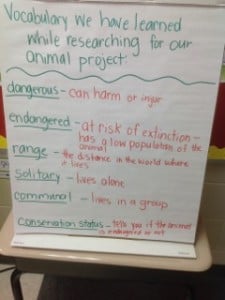
These are AMAZING vocabulary words. I found that my 2nd graders confused the term endangered with dangerous. They thought they meant the same. Through research and discussions in small groups, we discovered the meaning of both.
Once the students finished their individual research, they created a nonfiction magazine article for our class magazine on animals. They will use Publisher to design their magazine article. We used magazines in our room as models for layout designs. If you don’t have time for a magazine, you could always use Haiku Deck , Educreations, or any other creative app or website. The magazine articles continue throughout the project. Once the research was completed, we moved to the group part of the project but students continued working on their individual magazine articles. This is separate from the group project. 🙂
They also began thinking about reasons why the zoo should choose their animal.
One important side note: I knew I wanted this project to focus on science, writing and speaking standards. With the new CCRS (Alabama’s version of Common Core standards), students are expected to state an opinion and provide reasons for that opinion. I asked our reading coach to model the new Lucy Calkin’s unit on writing opinions during our writing block. She and I co-taught the lessons. Once we taught the first introductory lessons on writing opinions about favorite books, we moved the students to using the strategies with their animals. You do not have to use Lucy Calkins’ lessons but you will need to teach your students how to write an opinion with reasons to support it.
Writing an opinion beyond “because it’s cool” is hard for 2nd graders. I had to ask really good questions to help them think about the animal with the zoo in mind. Example: They would say, “The zoo should choose this animal because it’s so cute.” I would ask: “And why would the zoo want a cute animal?” They would say, “Because it’s cute.” and I would say “But how would this help the zoo?” They would eventually come up with a good reason such as “OH…people like to see cute animals so more people will come to the zoo!” Don’t give up and tell them. Just keep asking good questions! 🙂
Once the research was finished (or mostly finished for some), the students wrote a letter to their group. In the letter they wrote why their animal would be a good addition to the zoo and give reasons for this opinion. Each person in the group would share their letters to try to convince the group that their animal was the best for the zoo. The group choose 1 animal and then begin working on a presentation about that animal for the zoo. Did they all want their animal chosen? OF COURSE! But this is a good lesson in itself. Every student’s animal will be featured in the magazine article but only one will be the focus of the presentation.
Here is an example of one of their opinion letters:
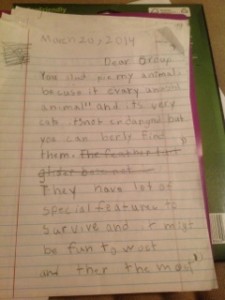
In case you can’t read it. Her letter says: (spelling corrected in typed version 🙂 )
Dear Group,
You should pick my animal because it is a very unusual animal! And it’s very cute. It’s not endangered but you can barely find them. They have lots of special features to survive and it might be fun to watch and they’re the most… (I didn’t take a picture of the back but she introduced her animal and talked about the special features of her animal.)
So we went from 19 animals to 5- one for each group. I was going to write about the fun rabbit trail here but this post was longer than anticipated. 🙂 I will write about it on the next post.
By the way, the letter above won over her team but just barely. 🙂 They all wrote very convincing letters!
Here are other examples of their letters:

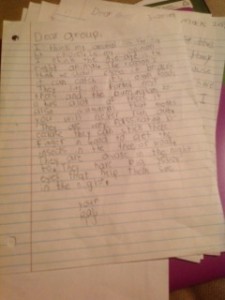
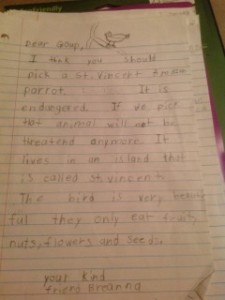
Part 4 is about the fun surprises that happen in project-based learning!
